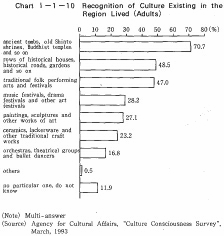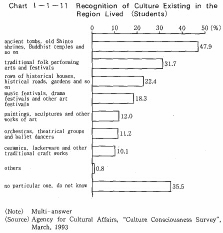| Home > Policy > White Paper, Notice, Announcement > White Paper > JAPANESE GOVERNMENT POLICIES IN EDUCATION, SCIENCE AND CULTURE 1993 > CHAPTER 1 �1 5 (4) | ||
Cultural properties exist in abundance throughout Japan, and have been handed down in their respective localities in various ways. When asked in the "Culture Consciousness Survey". "What types of culture exist in the region where you live?", adults responded, in order of frequency, "ancient tombs, old Shinto shrines, Buddhist temples and so on", "rows of historical houses, historical roads, gardens and so on", "traditional folk performing arts and festivals" and "music festivals, drama festivals and other art festivals". The number of those who mentioned forms of traditional culture far exceeded that of those who mentioned modern forms of culture (Chart I-1-10). In the localities, the top three replies included cultural properties, rows of historical houses and folk performing arts in all regions except for Hokkaido and Tohoku (more than 80% in Kinki and Kvushu). Among students, "ancient tombs, old Shinto shrines. Buddhist temples and so on" was the most popular answer, followed by "traditional folk performing arts and festivals "and "rows of historical houses, historical roads, gardens and so on" (Chart I- 1 -11).


Cultural properties are indispensable for gaining a correct understanding of Japan's past history and culture as well as being the foundation for creating future culture. They also play an important role in the community.
Based on an understanding of the level of people's consciousnessregarding cultural properties, these cultural properties should be preservedand utilized so that they can become an important and familiar part ofeveryday life.
In order to nermeate the rcublic with a snirit of understandinz of andresaect for cultural rcror>erties. encouraging interest in this area (esneciallvamong the young) will become an important future task. It will becomeimportant to include experiential lessons for this purpose in school education.
| Back to Top | MEXT HOME |